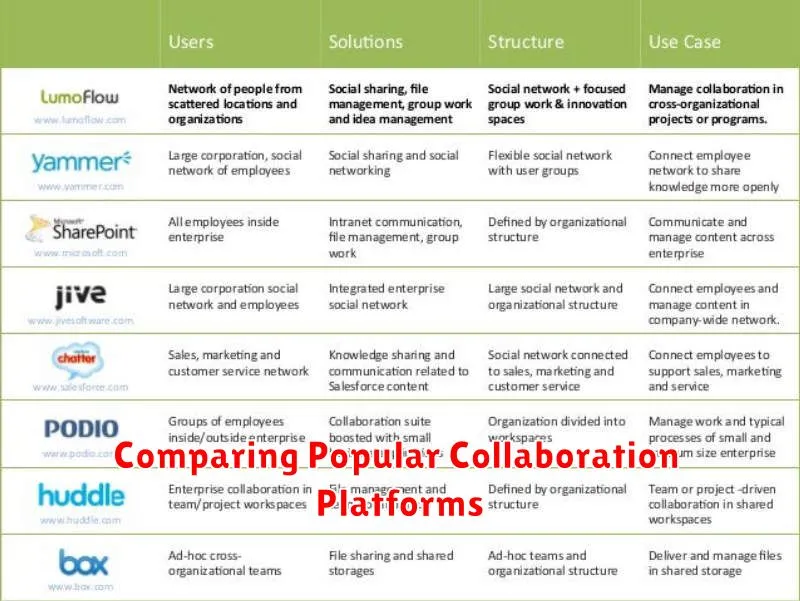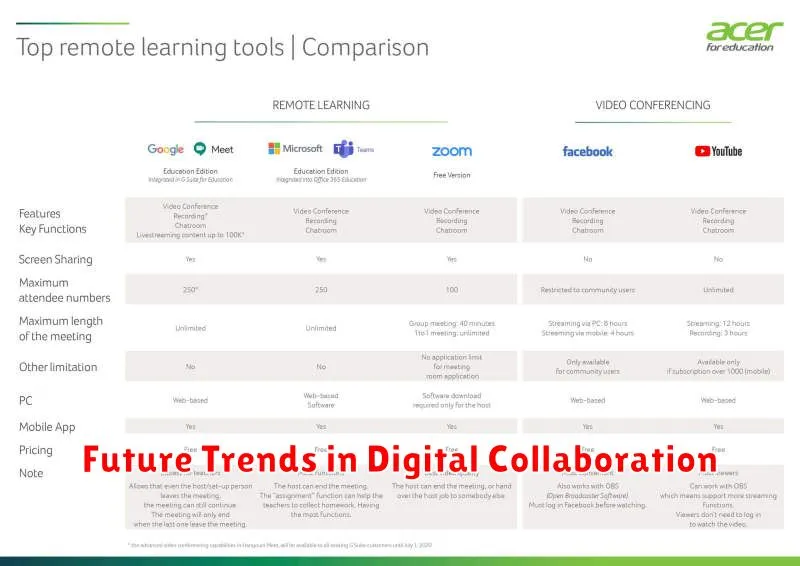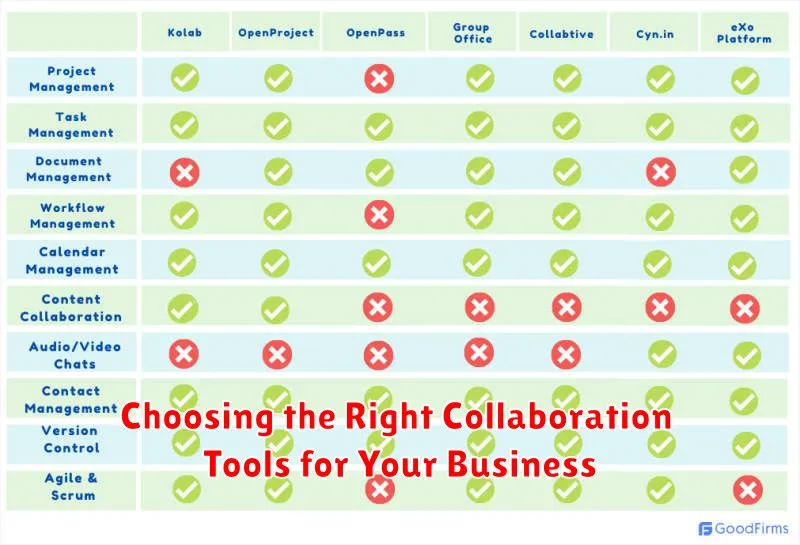In today’s interconnected world, collaboration tools are essential for businesses of all sizes. Choosing the right tools can significantly impact productivity, communication, and overall success. This article will guide you through the process of selecting the most effective collaboration tools for your specific business needs. We will explore key features, consider various types of tools, and discuss factors that will influence your decision-making process. From project management platforms and video conferencing software to instant messaging applications and file sharing systems, understanding the available options is the first step towards optimized collaboration.
Finding the perfect balance between functionality, ease of use, and cost is crucial when selecting collaboration tools. This article will equip you with the knowledge to navigate the diverse landscape of collaboration platforms, enabling you to make informed choices. By carefully evaluating your business requirements and considering the unique needs of your team, you can implement the right tools to foster seamless communication, streamline workflows, and ultimately enhance productivity and growth. Let’s delve into the key considerations for choosing the collaboration tools that will best serve your organization.
Why Collaboration Tools Matter
In today’s interconnected business world, collaboration tools are essential for success. They streamline communication, improve teamwork, and boost productivity. By providing a central platform for information sharing and project management, these tools empower teams to work together more effectively, regardless of location.
Improved communication eliminates information silos and ensures everyone stays informed. Enhanced teamwork fosters a stronger sense of community and shared purpose. Increased productivity results from reduced delays and streamlined workflows.
Evaluating Your Team’s Needs
Before diving into the myriad of collaboration tools available, it’s crucial to understand your team’s specific needs. A thorough evaluation will save you time and resources in the long run.
Consider the following:
- Communication: What are the primary communication methods used within your team? Do you rely heavily on instant messaging, video conferencing, or email?
- Project Management: How are projects currently managed? Is there a need for task assignment, progress tracking, and file sharing capabilities?
- Security: What level of security is required for your data and communications? Are there industry-specific compliance requirements to consider?
- Budget: What’s your budget for collaboration tools? Consider both upfront costs and ongoing subscription fees.
Comparing Popular Collaboration Platforms

Selecting the right collaboration platform is crucial for streamlining communication and boosting productivity. This comparison examines key features of popular options to aid in your decision-making process.
| Feature | Platform A | Platform B | Platform C |
|---|---|---|---|
| Real-time Chat | Yes | Yes | Limited |
| File Sharing | Yes | Yes | Yes |
| Video Conferencing | Limited | Yes | Yes |
| Task Management | Basic | Advanced | Basic |
| Integration Options | Limited | Extensive | Moderate |
Each platform offers a unique set of features catering to different needs. Consider your team’s communication style and workflow when making your selection.
Features to Consider: Messaging, Tasks, Meetings
When evaluating collaboration tools, prioritize core features like messaging, task management, and meeting capabilities. Effective communication is paramount. Look for tools offering real-time messaging, threaded conversations, and channel organization to streamline communications and reduce email clutter.
Task management features are crucial for project success. Consider tools that provide task assignment, deadlines, progress tracking, and collaborative workspaces. This ensures projects stay on track and team members are aligned.
Finally, integrated meeting functionalities like video conferencing, screen sharing, and recording are essential for remote collaboration. Evaluate the ease of use and reliability of these features to ensure seamless virtual meetings.
Integration Capabilities with Other Tools
Seamless integration with existing business tools is a critical factor when selecting collaboration software. Evaluate whether the platform integrates with your CRM, project management software, and other frequently used applications. This interoperability streamlines workflows and prevents data silos.
Consider the types of integrations offered. Some platforms provide native integrations, while others rely on third-party connectors or APIs. Native integrations often offer a smoother, more reliable experience. However, API access can provide greater flexibility and customization.
Security and Privacy Features
Security and privacy are paramount when selecting collaboration tools. Evaluate features like end-to-end encryption for messages and files, two-factor authentication for login security, and access controls to manage user permissions.
Consider data residency and compliance certifications relevant to your industry, such as GDPR, HIPAA, or SOC 2. Ensure the platform offers robust data loss prevention mechanisms.
Scalability for Growing Teams
As your team expands, your collaboration tools must keep pace. Scalability refers to a platform’s ability to handle increasing workloads and users without sacrificing performance. Choosing a scalable solution is crucial for future growth.
Consider factors like the maximum number of users supported, storage capacity, and the availability of integration options with other business tools. A platform with limited scalability can hinder productivity and create bottlenecks as your team grows.
Cost Analysis and ROI
A thorough cost analysis is crucial when selecting collaboration tools. Consider not only the initial purchase price, but also ongoing subscription fees, implementation costs, and potential training expenses.
Calculating the return on investment (ROI) can be more complex. While some benefits, such as increased productivity, are quantifiable, others, like improved communication, are harder to measure. Focus on identifying key performance indicators (KPIs) relevant to your business goals, such as reduced project completion times or improved customer satisfaction.
Compare the total cost of ownership (TCO) of different tools against their projected ROI to make informed decisions. A less expensive tool with limited features might offer a lower ROI than a more comprehensive, albeit pricier, solution.
Encouraging Adoption Among Employees
Successfully implementing new collaboration tools requires active employee adoption. Training is crucial. Provide clear, concise training sessions tailored to different learning styles. Hands-on workshops and readily available support materials can ease the transition.
Highlight the benefits for individual employees, not just the company. Explain how these tools can simplify their workflows, improve communication, and boost productivity.
Encourage early adopters within teams to champion the new tools and mentor their colleagues. Recognize and reward successful adoption to foster a positive and encouraging environment.
Future Trends in Digital Collaboration

The future of digital collaboration is rapidly evolving, driven by the need for increased flexibility and productivity. Several key trends are shaping this landscape.
Artificial intelligence (AI) will play a larger role, automating tasks, providing insights, and personalizing collaboration experiences. Expect to see more intelligent assistants and smarter project management tools.
Virtual and augmented reality (VR/AR) offer immersive collaboration opportunities, enabling remote teams to interact in shared virtual spaces. This can enhance design reviews, training sessions, and other collaborative activities.
The metaverse represents a potential future for collaboration, offering persistent virtual worlds where teams can work, socialize, and innovate together.
Emphasis on asynchronous communication will continue to grow, allowing teams to collaborate effectively across different time zones and schedules. Tools that support flexible communication and workflows will become increasingly important.

